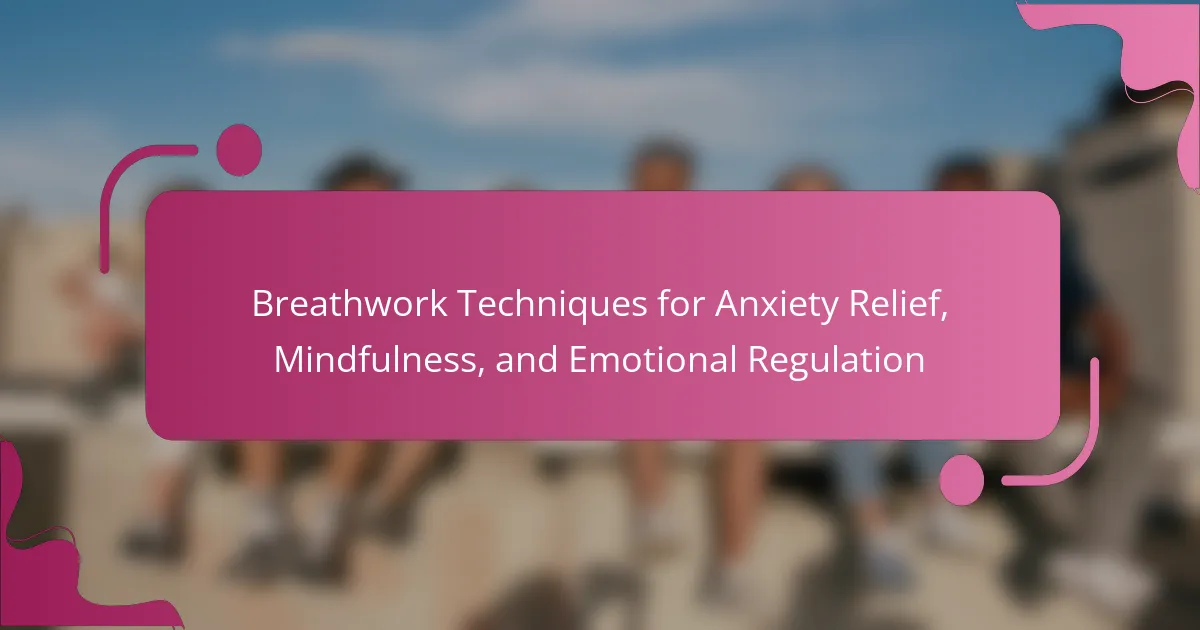Breathwork techniques offer effective relief from anxiety by promoting relaxation and emotional regulation. These practices enhance mindfulness through focused breathing, helping to reduce stress and improve mental health. Techniques like diaphragmatic breathing and box breathing activate the parasympathetic nervous system, leading to decreased cortisol levels and increased emotional stability. Cultural variations of breathwork also provide unique insights into emotional balance and self-awareness.

How do breathwork techniques alleviate anxiety symptoms?
Breathwork techniques effectively alleviate anxiety symptoms by promoting relaxation and emotional regulation. These practices enhance mindfulness, allowing individuals to focus on their breath and reduce stress. Techniques such as diaphragmatic breathing and box breathing can lower heart rate and decrease cortisol levels, leading to a calmer state of mind. Research indicates that regular breathwork can improve overall mental health and resilience against anxiety triggers.
What physiological processes are influenced by breathwork?
Breathwork techniques significantly influence physiological processes such as stress reduction, heart rate variability, and oxygenation. These techniques activate the parasympathetic nervous system, promoting relaxation and emotional regulation. Breathwork can enhance mindfulness by grounding individuals in the present moment, leading to improved mental clarity. Additionally, specific breath patterns can stimulate the vagus nerve, which plays a crucial role in regulating the body’s stress response.
Which specific techniques are most effective for anxiety relief?
Breathwork techniques such as diaphragmatic breathing, box breathing, and 4-7-8 breathing are highly effective for anxiety relief. These methods help regulate emotions and promote mindfulness. Diaphragmatic breathing focuses on deep, abdominal breaths, enhancing oxygen flow and reducing tension. Box breathing involves inhaling, holding, exhaling, and pausing for equal counts, fostering calmness. The 4-7-8 technique combines inhalation for four seconds, holding for seven, and exhaling for eight, which can significantly reduce anxiety levels. Regular practice of these techniques can improve emotional regulation over time.
How does breath awareness enhance emotional regulation?
Breath awareness significantly enhances emotional regulation by fostering mindfulness and reducing anxiety. It encourages individuals to focus on their breathing patterns, which helps create a sense of calm and control. This technique activates the parasympathetic nervous system, promoting relaxation and lowering stress levels. Studies show that consistent breathwork can lead to improved emotional resilience, enabling better responses to challenging situations. Incorporating breath awareness into daily routines can transform emotional responses and contribute to overall mental well-being.
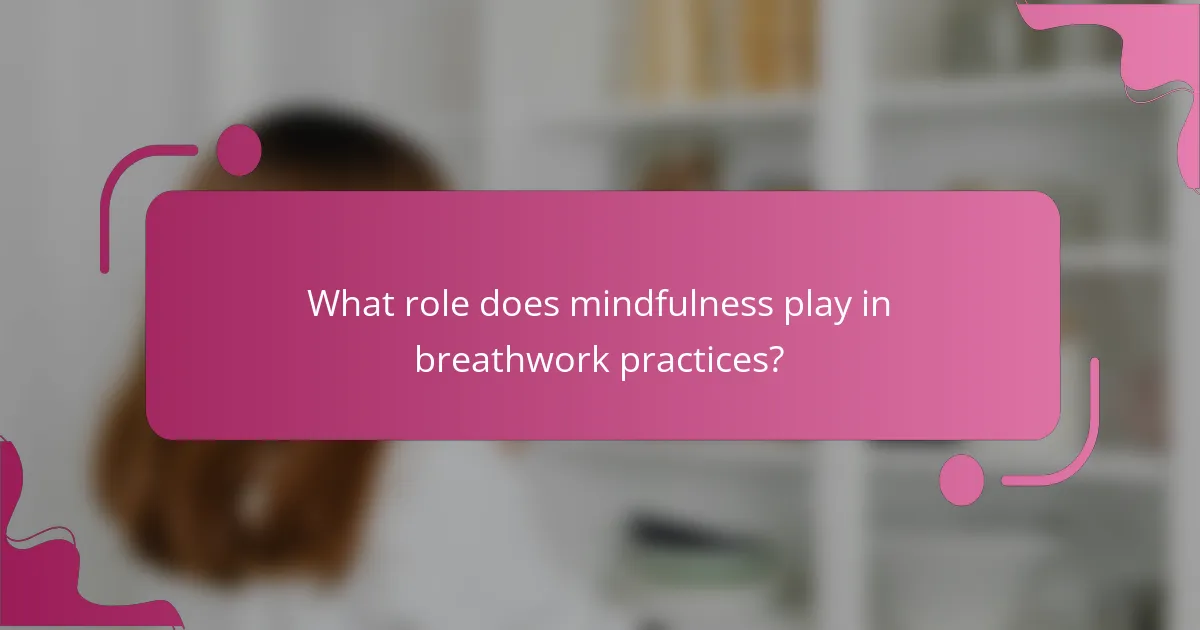
What role does mindfulness play in breathwork practices?
Mindfulness enhances breathwork practices by promoting present-moment awareness and emotional regulation. By focusing on breath, individuals can reduce anxiety and cultivate a deeper connection to their feelings. This practice encourages a calm state, allowing for better emotional responses and resilience. Research shows that mindfulness integrated into breathwork can significantly lower stress levels and improve overall mental well-being.
How can breathwork contribute to present-moment awareness?
Breathwork enhances present-moment awareness by grounding individuals in their breath, promoting mindfulness. Techniques like diaphragmatic breathing and box breathing reduce anxiety and foster emotional regulation. These practices encourage focus on the here and now, minimizing distractions. As a result, individuals experience heightened clarity and calmness, improving overall mental well-being.
Which mindfulness strategies complement breathwork?
Mindfulness strategies that complement breathwork include body scanning, mindful walking, and meditation. These techniques enhance emotional regulation and anxiety relief by promoting awareness and presence. Body scanning involves focusing attention on different body parts, helping to release tension. Mindful walking encourages awareness of movement and surroundings, fostering a sense of calm. Meditation, particularly focused attention or loving-kindness practices, deepens the breathwork experience and cultivates emotional resilience. Integrating these techniques can lead to a more comprehensive mindfulness practice.
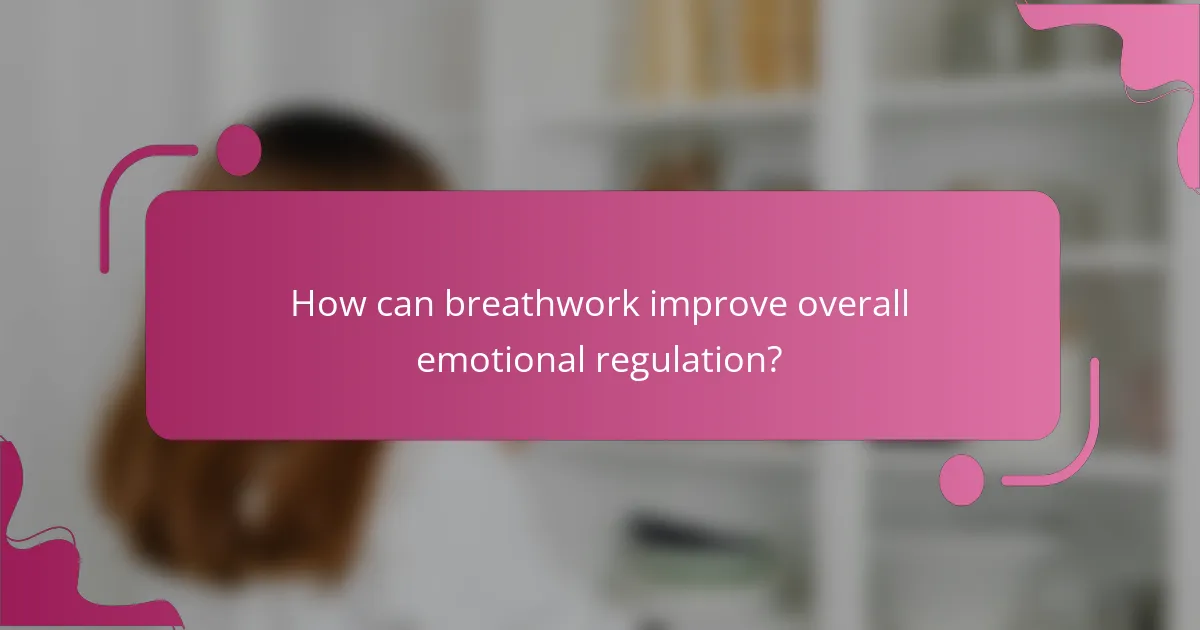
How can breathwork improve overall emotional regulation?
Breathwork techniques significantly enhance emotional regulation by promoting relaxation and reducing anxiety. Techniques such as diaphragmatic breathing and box breathing activate the parasympathetic nervous system, leading to decreased stress levels. Research indicates that consistent practice can lower cortisol levels, fostering emotional stability. Additionally, breathwork cultivates mindfulness, allowing individuals to observe their thoughts and feelings without judgment, which further aids in emotional control.
What are the benefits of regulated breathing patterns?
Regulated breathing patterns offer numerous benefits, including reduced anxiety, enhanced mindfulness, and improved emotional regulation. These techniques promote relaxation by activating the parasympathetic nervous system, which counteracts stress responses.
Breathwork can lower cortisol levels, leading to decreased feelings of anxiety. It also fosters a state of mindfulness, allowing individuals to focus on the present moment and reduce rumination. Additionally, consistent practice enhances emotional regulation, helping individuals manage their feelings more effectively.
Research indicates that breathwork can lead to measurable improvements in mental health. For instance, a study found that participants practicing regulated breathing reported a 30% reduction in anxiety symptoms.
Incorporating breathwork into daily routines can create long-term benefits. Regular practice not only cultivates resilience against stress but also enhances overall well-being.
Which breathwork techniques support emotional resilience?
Breathwork techniques such as diaphragmatic breathing, box breathing, and alternate nostril breathing enhance emotional resilience. These methods promote relaxation, reduce anxiety, and improve emotional regulation. Diaphragmatic breathing increases oxygen flow, while box breathing offers a structured approach to mindfulness. Alternate nostril breathing balances the nervous system, fostering calmness. Regular practice of these techniques can lead to lasting emotional benefits.
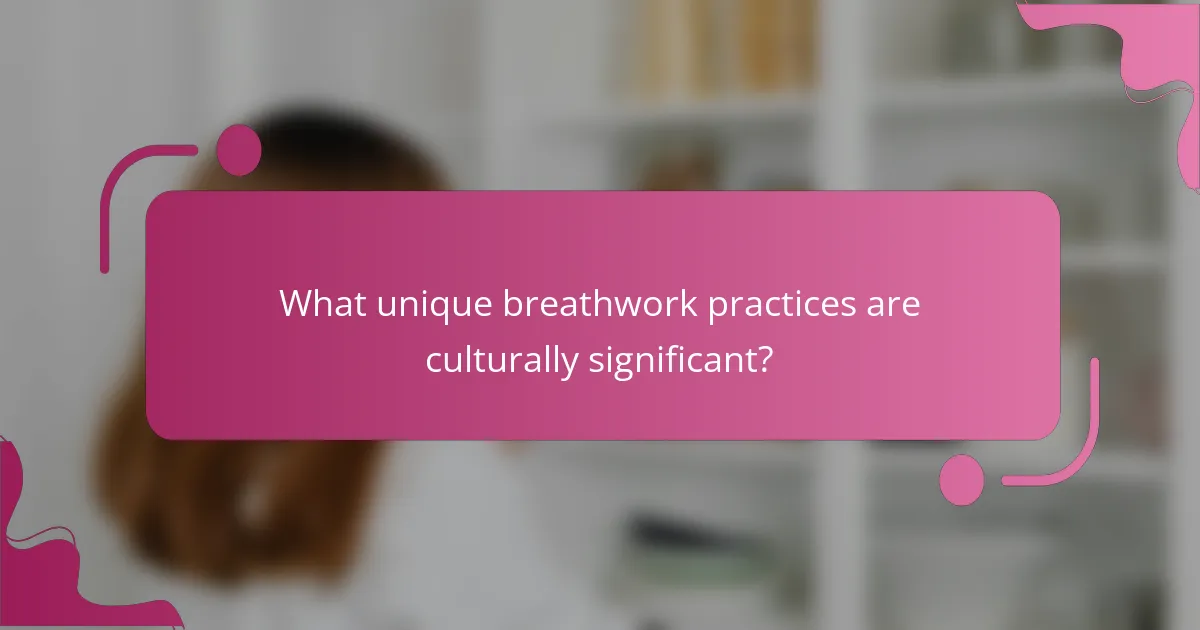
What unique breathwork practices are culturally significant?
Unique breathwork practices that hold cultural significance include various techniques from different traditions. For instance, Pranayama from yoga emphasizes controlled breathing for emotional balance. Sudarshan Kriya, rooted in the Art of Living, utilizes rhythmic breathing to enhance mental clarity. In Native American culture, breathwork is often integrated with rituals, promoting spiritual connection. Tibetan Buddhist practices focus on breath as a means to achieve mindfulness and tranquility. These practices not only alleviate anxiety but also foster a deeper understanding of self and community.
How do different cultures approach breathwork for emotional health?
Different cultures utilize breathwork uniquely to enhance emotional health. In many Eastern traditions, such as yoga and Tai Chi, breath control is integral to achieving mindfulness and emotional balance. These practices emphasize slow, deep breathing to reduce anxiety and promote relaxation.
Conversely, Western approaches often incorporate techniques like Holotropic Breathwork, which focuses on accelerated breathing patterns to access altered states of consciousness. This method can facilitate emotional release and self-discovery.
Indigenous cultures frequently blend breathwork with rituals, using it to connect with spiritual realms and foster community healing. This cultural context highlights the social aspect of breathwork, reinforcing emotional regulation through shared experiences.
Overall, while the techniques may vary, the core goal remains consistent: using breath to enhance emotional well-being across diverse cultural landscapes.
What are some lesser-known breathwork techniques from around the world?
Lesser-known breathwork techniques from around the world include Sudarshan Kriya, a rhythmic breathing practice from India, and Buteyko breathing, which focuses on nasal breathing to reduce anxiety. Other techniques include Tummo, a Tibetan method that generates body heat through breath control, and Pranayama, an ancient yogic practice emphasizing breath regulation for emotional balance. Each technique offers unique benefits for anxiety relief and mindfulness.
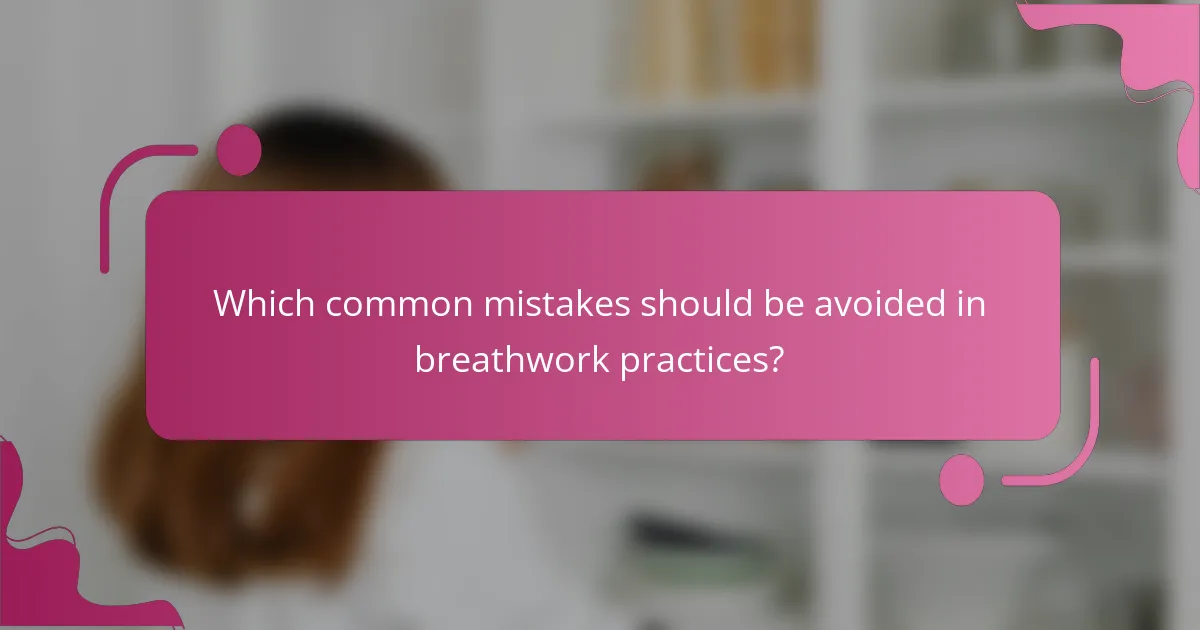
Which common mistakes should be avoided in breathwork practices?
Common mistakes in breathwork practices include improper technique, neglecting personal limits, and inconsistent practice. Focusing too much on results can lead to frustration. It’s vital to prioritize comfort and awareness during sessions. Additionally, skipping preparation or post-session reflection can diminish benefits.
How can improper technique hinder emotional benefits?
Improper technique can significantly hinder the emotional benefits of breathwork. Incorrect practices may lead to increased anxiety, physical discomfort, or emotional distress, negating the intended calming effects. For instance, shallow breathing can elevate stress levels rather than reduce them. Proper technique enhances mindfulness and emotional regulation, while improper execution may create a barrier to achieving these benefits. Consistent practice with correct methods is essential for maximizing breathwork’s positive impact on emotional health.
What are the signs of ineffective breathwork?
Signs of ineffective breathwork include feelings of dizziness, anxiety, or discomfort. Additionally, if breathwork does not lead to relaxation or emotional clarity, it may not be effective. Participants might also experience shallow breathing or an inability to focus, indicating a disconnect from the practice. Regular practice should yield a sense of calm; lack of progress suggests a need for adjustment.
What expert tips can enhance breathwork effectiveness?
To enhance breathwork effectiveness, focus on techniques that promote mindfulness and emotional regulation. Incorporating consistent practice, setting clear intentions, and utilizing specific breathing patterns can significantly improve outcomes.
1. Establish a routine: Practice breathwork daily to build familiarity and deepen relaxation.
2. Use guided sessions: Listen to expert-led recordings to maintain focus and structure.
3. Experiment with techniques: Try diaphragmatic breathing, box breathing, or alternate nostril breathing to find what works best for you.
4. Create a conducive environment: Choose a quiet space with minimal distractions to enhance concentration.
5. Combine with meditation: Integrate breathwork with mindfulness meditation for greater emotional clarity.
6. Reflect on your experience: Journaling post-session can help track progress and emotional shifts.
